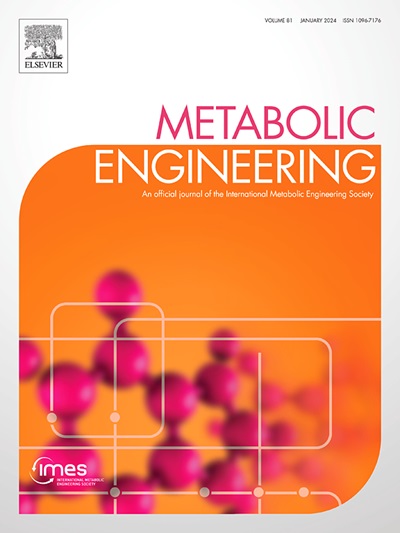基因源优化促进裸盖菇素生物合成
IF 6.8
1区 生物学
Q1 BIOTECHNOLOGY & APPLIED MICROBIOLOGY
引用次数: 0
摘要
裸盖菇素是“神奇”蘑菇中精神活性化合物的前药,目前正在临床试验中用于治疗严重的精神健康状况,如抑郁症和焦虑症。以前在大肠杆菌中重组裸盖菇素生物合成的报道报道了最大滴度为1.16 g/L,完全使用来自最常见的休闲蘑菇裸盖菇的基因。本研究利用从产生裸盖菇素的蘑菇Psilocybe cubensis、Psilocybe cyanescens、Panaeolus cyanescens和Gymnopilus dilepis中提取的各种外源基因,探讨了基因物种变异对裸盖菇素和baeocytin产量的影响。psiD和psiK基因的表现明显优于psiK基因,而psiM基因的裸盖菇素和途径中间体baeocytin的产生水平随基因来源的变化而变化。与其他psiM基因相比,含有裸盖菇psiM基因的菌株对baeocybe cyanescens具有更高的选择性,这表明物种之间存在关键差异。最值得注意的是,含有裸盖菇素的菌株Gymdi30的裸盖菇素滴度为1.46±0.13 g/L,是迄今为止报道的最高滴度。在高产和低产量时期,我们还对Gymdi30进行了比较蛋白质组学分析,以研究可能限制菌株表现的细胞代谢瓶颈。这项工作代表了裸盖菇素生物合成的重大改进,是开发裸盖菇素生物合成制造路线的关键一步。本文章由计算机程序翻译,如有差异,请以英文原文为准。
Psilocybin biosynthesis enhancement through gene source optimization
Psilocybin, the prodrug to the psychoactive compound in ‘magic’ mushrooms, is currently being studied in clinical trials as a treatment for severe mental health conditions, such as depression and anxiety. Previous reports of psilocybin biosynthesis as reconstituted in E. coli reported maximum titers of 1.16 g/L, exclusively using genes from the most common recreationally used mushroom, Psilocybe cubensis. This study explores the effect of gene species variation on psilocybin and baeocystin production using various exogenous genes sourced from psilocybin-producing mushrooms Psilocybe cubensis, Psilocybe cyanescens, Panaeolus cyanescens, and Gymnopilus dilepis. The psiD and psiK genes sourced from P. cubensis demonstrated unequivocally superior performance, while psiM showed varied production levels of psilocybin and the pathway intermediate baeocystin with changes in gene source. Strains containing a psiM gene sourced from Psilocybe cyanescens demonstrated a higher degree of baeocystin selectivity as compared to other psiM genes, demonstrating a key difference between species. Most notably, the strain Gymdi30, containing psiM sourced from G. dilepis, achieved a psilocybin titer of 1.46 ± 0.13 g/L, the highest reported to date. Comparative proteomic analysis of Gymdi30 during periods of high and low productivity was also performed to investigate bottlenecks in cellular metabolism, which could be limiting strain performance. This work represents a significant improvement in psilocybin biosynthesis, a key step towards the development of a biosynthetic manufacturing route for psilocybin.
求助全文
通过发布文献求助,成功后即可免费获取论文全文。
去求助
来源期刊

Metabolic engineering
工程技术-生物工程与应用微生物
CiteScore
15.60
自引率
6.00%
发文量
140
审稿时长
44 days
期刊介绍:
Metabolic Engineering (MBE) is a journal that focuses on publishing original research papers on the directed modulation of metabolic pathways for metabolite overproduction or the enhancement of cellular properties. It welcomes papers that describe the engineering of native pathways and the synthesis of heterologous pathways to convert microorganisms into microbial cell factories. The journal covers experimental, computational, and modeling approaches for understanding metabolic pathways and manipulating them through genetic, media, or environmental means. Effective exploration of metabolic pathways necessitates the use of molecular biology and biochemistry methods, as well as engineering techniques for modeling and data analysis. MBE serves as a platform for interdisciplinary research in fields such as biochemistry, molecular biology, applied microbiology, cellular physiology, cellular nutrition in health and disease, and biochemical engineering. The journal publishes various types of papers, including original research papers and review papers. It is indexed and abstracted in databases such as Scopus, Embase, EMBiology, Current Contents - Life Sciences and Clinical Medicine, Science Citation Index, PubMed/Medline, CAS and Biotechnology Citation Index.
 求助内容:
求助内容: 应助结果提醒方式:
应助结果提醒方式:


